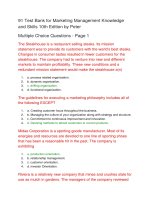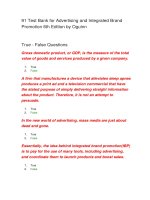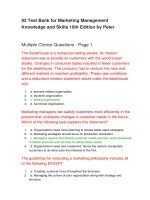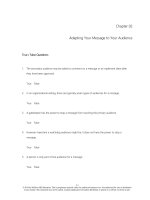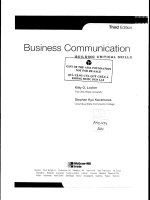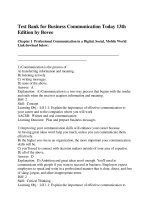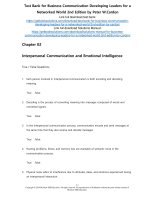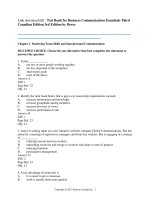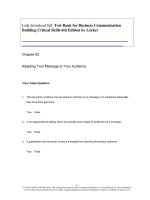Test bank for business communication building critical skills 6th edition by locker
Bạn đang xem bản rút gọn của tài liệu. Xem và tải ngay bản đầy đủ của tài liệu tại đây (527.81 KB, 58 trang )
Link download full: Test Bank for Business Communication
Building Critical Skills 6th Edition by Locker
Chapter 02
Adapting Your Message to Your Audience
True / False Questions
1. The secondary audience may be asked to comment on a message or to implement ideas after
they have been approved.
True
False
2. In an organizational setting, there are typically seven types of audiences for a message.
True
False
3. A gatekeeper has the power to stop a message from reaching the primary audience.
True
False
2-1
© 2014 by McGraw-Hill Education. This is proprietary material solely for authorized instructor use. Not authorized for sale or distribution
in any manner. This document may not be copied, scanned, duplicated, forwarded, distributed, or posted on a website, in whole or part.
/>4. However important a watchdog audience might be, it does not have the power to stop a
message.
True
False
5. A person is only part of one audience for a message.
True
False
6. The secondary audience pays close attention to the transaction between the writers and the
primary audience and may base future actions on its evaluation of the message.
True
False
7. Messages seldom need to be adapted to an audience—humans by nature are adaptable and will
find a way to understand the message.
True
False
8. Of the six questions in PAIBOC, five relate to the audience.
True
False
9. All audiences have the same attitudes.
True
False
10. The communication process begins with a person interpreting the information.
True
False
2-2
© 2014 by McGraw-Hill Education. This is proprietary material solely for authorized instructor use. Not authorized for sale or distribution
in any manner. This document may not be copied, scanned, duplicated, forwarded, distributed, or posted on a website, in whole or part.
/>11. The stage of putting ideas into words and other nonverbal symbols is called interpreting.
True
False
12. Noise hinders the receiver from decoding a message accurately.
True
False
13. Psychological noise could include handwriting that is hard to read.
True
False
14. Channel overload occurs when more messages are transmitted than the human receiver can
handle.
True
False
15. Miscommunication can occur because different people have different frames of reference.
True
False
16. Empathy is the ability to put oneself in someone else's shoes, to feel with that person.
True
False
17. One way to remind readers of information in a tactful way is to preface statements with "As you
may know."
True
False
2-3
© 2014 by McGraw-Hill Education. This is proprietary material solely for authorized instructor use. Not authorized for sale or distribution
in any manner. This document may not be copied, scanned, duplicated, forwarded, distributed, or posted on a website, in whole or part.
/>18. Demographic characteristics are measurable features that can be counted objectively.
True
False
19. Myers-Briggs Type Indicator is used to classify people based on race and ethnicity.
True
False
20. Psychographic characteristics are quantitative rather than qualitative.
True
False
21. Strivers are motivated by achievement and are relatively low in resources and innovation.
True
False
22. One strategy to keep in mind while writing to an audience is to protect the reader's ego.
True
False
23. When delivering bad news, it is important to get to the point quickly.
True
False
24. It is important to use "academic," not conversational, language in a message.
True
False
25. In the body of the document, it is important to provide enough detail for primary audiences and for
anyone who could veto the proposal.
True
False
2-4
© 2014 by McGraw-Hill Education. This is proprietary material solely for authorized instructor use. Not authorized for sale or distribution
in any manner. This document may not be copied, scanned, duplicated, forwarded, distributed, or posted on a website, in whole or part.
/>26. It is important to connect personally with the audience by using informal language like "You" in
the message.
True
False
27. In the body of a document, it is important to assume the degree of knowledge that primary
audiences will have.
True
False
28. A written message makes it easier to get immediate action or response.
True
False
29. E-mail messages are appropriate for someone to whom the writer is writing to for the first time.
True
False
30. Important messages should use more formal channels, whether they're oral or written.
True
False
Multiple Choice Questions
2-5
© 2014 by McGraw-Hill Education. This is proprietary material solely for authorized instructor use. Not authorized for sale or distribution
in any manner. This document may not be copied, scanned, duplicated, forwarded, distributed, or posted on a website, in whole or part.
/>31. Lorie routinely arrives at the office five to ten minutes late. Her boss, Carl, seems unconcerned
about it, as do her co-workers. However, when Frank wants to leave a few minutes early one day,
Carl reprimands him for not finishing his work first. What does this behavior best suggest about
the organizational culture?
A. The organization does not tolerate employees who are not punctual.
B. The organization tolerates women employees arriving late but do not tolerate male employees
leaving early.
C. The organization is concerned about getting the work done rather than enforcing punctuality.
D. The organization is managed by an ineffective boss who favors certain employees over
others.
E. None of the above
32. Tracy is presenting a proposal to the City Council at a public meeting. Which of the following is
her primary audience?
A. The TV journalists filming the presentation
B. The council members who will vote on the proposal
C. Her boss, who has promised her a raise if the proposal is accepted by the Council
D. The speakers following Tracy who will have a chance to criticize her proposal
E. None of the above
2-6
© 2014 by McGraw-Hill Education. This is proprietary material solely for authorized instructor use. Not authorized for sale or distribution
in any manner. This document may not be copied, scanned, duplicated, forwarded, distributed, or posted on a website, in whole or part.
/>33. Which of the following audiences may stop a message from getting to its intended audience?
A. Primary audience
B. Secondary audience
C. Initial audience
D. Watchdog audience
E. None of the above
34. A watchdog audience:
A. has the authority to keep a message from getting to the primary audience.
B. has the ability to act directly on a message in lieu of the primary audience.
C. has the ability to cancel a message from the start.
D. has political, social, or economic power.
E. seldom pays attention to the transactions between the speaker/writer and the primary
audience.
35. Jordan, an auditor in an accounting firm, is required to write a report to the client as soon as he
completes an audit. The client would be classified as a _____.
A. primary audience
B. universal audience
C. secondary audience
D. gatekeeper
E. watchdog
2-7
© 2014 by McGraw-Hill Education. This is proprietary material solely for authorized instructor use. Not authorized for sale or distribution
in any manner. This document may not be copied, scanned, duplicated, forwarded, distributed, or posted on a website, in whole or part.
/>36. Judy is the marketing head in a company. Which of the following situations would require her to
be considered both as a primary audience and an initial audience?
A. Judy asks Patricia to compile sales figures for the last fiscal year so she can send them on to
her boss, who needs the information to prepare himself for an upcoming board meeting.
B. The company's newsletter needs information on each department's softball team, which Judy
wants to see before it's passed on to the editor.
C. Will writes a proposal to Judy suggesting a new promotional idea with the hope that she will
like it enough to pass it on to the division chief, who has the power to implement a new plan.
D. Judy asks Jake to compile sales figures and put them in an informative report so she can
decide if his new marketing strategies have paid off.
E. None of the above
37. Which of the following is not a component of the communication model?
A. Sender
B. Receiver
C. Message
D. Channel
E. Compiler
2-8
© 2014 by McGraw-Hill Education. This is proprietary material solely for authorized instructor use. Not authorized for sale or distribution
in any manner. This document may not be copied, scanned, duplicated, forwarded, distributed, or posted on a website, in whole or part.
/>38. Which of the following is true of the communication process?
A. It begins with the sender perceiving some stimulus.
B. It begins with the interpretation of the message.
C. Noise can interfere with the message exclusively during feedback.
D. The receiver will first decode the message.
E. Information overload occurs when the channel cannot handle all the messages that are being
sent.
39. Person A decides to send a message to Person B. Person A first perceives a stimulus and then
interprets that perception. Which of the following is the next stage in the communication
process?
A. Encoding, or putting ideas into symbols
B. Choosing the information to send to Person B
C. Decoding the proposed message
D. Offering feedback
E. None of the above
2-9
© 2014 by McGraw-Hill Education. This is proprietary material solely for authorized instructor use. Not authorized for sale or distribution
in any manner. This document may not be copied, scanned, duplicated, forwarded, distributed, or posted on a website, in whole or part.
/>40. Lisa is a part of the audience that is watching a panel of top business executives engage in a
heated debate. Some members are talking simultaneously, one member is explaining her views
through visual aids, and yet another is trying to answer questions from the audience. Lisa can't
keep up with all this simultaneous communication. Which of the following terms best exemplifies
the difficulty she faces?
A. Channel overload
B. Information overload
C. Misperception
D. Transmission interruption
E. None of the above
41. Which of the following is a tactful way to remind readers of information?
A. Give a brief definition in the text
B. Ask readers if they need or want additional information
C. Spell out acronyms the first time they are used
D. Ensure that readers use the Internet to search for information at that very instant
E. Both A and C
42. Forever young beauty is a new anti-wrinkle skin cream targeting women over the age of 50.
Which of the following will help the company in effectively marketing their new product?
A. Geographic factors
B. Myers-Briggs Type Indicator
C. Demographic factors
D. A and B only
E. None of the above
2-10
© 2014 by McGraw-Hill Education. This is proprietary material solely for authorized instructor use. Not authorized for sale or distribution
in any manner. This document may not be copied, scanned, duplicated, forwarded, distributed, or posted on a website, in whole or part.
/>43. The marketing head of a luxury food brand is reviewing potential customers using the VALS
system. What VALS category is the company most likely to target?
A. Thinkers
B. Believers
C. Achievers
D. Experiencers
E. Innovators
44. Which of the following should a writer follow when adapting a message to meet audiences'
needs?
A. The writer must take care to protect the audiences' ego.
B. The writer must use hot button words to connect with the audience.
C. The writer should use academic, not conversational language.
D. The writer should exclusively use a soft-sell approach.
E. None of the above
45. Which of the following is useful when developing the style for an effective message?
A. Using complex jargon to impress the audience
B. Using hot button words
C. Using conversational, not "academic," language
D. Using sentences of the same length
E. All of the above
2-11
© 2014 by McGraw-Hill Education. This is proprietary material solely for authorized instructor use. Not authorized for sale or distribution
in any manner. This document may not be copied, scanned, duplicated, forwarded, distributed, or posted on a website, in whole or part.
/>46. Appendices are used in messages to:
A. provide an overview or executive summary for readers who just want the main points.
B. provide information that primary audiences don't need.
C. provide irrelevant and vague information.
D. act as table of contents so that readers can turn to the portions that interest them.
E. exclusively explain the common technical terms used in the document that all the audiences
are aware of.
47. If primary audiences will have more knowledge than other audiences then writers must:
A. cover the simpler topics exclusively.
B. skim through the topics quickly.
C. merge all the paragraphs into one.
D. assume that the other audiences would make an effort to acquire information via the Internet
prior to receiving the message.
E. provide a glossary of terms.
48. Which of the following must be avoided when drafting an effective message?
A. Use of table of contents
B. Use of glossary
C. Use of personal pronouns
D. Use of appendices
E. Use of sentences of varying lengths
2-12
© 2014 by McGraw-Hill Education. This is proprietary material solely for authorized instructor use. Not authorized for sale or distribution
in any manner. This document may not be copied, scanned, duplicated, forwarded, distributed, or posted on a website, in whole or part.
/>49. Trevor is required to present details of investment policies at his firm to a potential client. Which
of the following channels of communication would be most effective in this case?
A. Written message on paper
B. Written message via e-mail
C. Oral message via phone
D. Oral message via video conference
E. None of the above
50. Oral messages make it easier to:
A. present many specific details of a law, policy, or procedure.
B. present extensive or complex financial data.
C. minimize undesirable emotions.
D. get immediate action or response.
E. focus the audience's attention on all the points being said.
Short Answer Questions
2-13
© 2014 by McGraw-Hill Education. This is proprietary material solely for authorized instructor use. Not authorized for sale or distribution
in any manner. This document may not be copied, scanned, duplicated, forwarded, distributed, or posted on a website, in whole or part.
/>51. How many kinds of audiences are present in an organizational setting?
52. Discuss how PAIBOC relates to audience analysis.
53. What is information overload?
2-14
© 2014 by McGraw-Hill Education. This is proprietary material solely for authorized instructor use. Not authorized for sale or distribution
in any manner. This document may not be copied, scanned, duplicated, forwarded, distributed, or posted on a website, in whole or part.
/>54. List the four dimensions of the Myers-Briggs Type Indicator.
55. Differentiate between the use of demographics and psychographics in audience analysis.
56. What are VALS profiles?
2-15
© 2014 by McGraw-Hill Education. This is proprietary material solely for authorized instructor use. Not authorized for sale or distribution
in any manner. This document may not be copied, scanned, duplicated, forwarded, distributed, or posted on a website, in whole or part.
/>57. When is it acceptable to take a while to make a point?
58. Briefly explain what "red flag" words are and why they should be avoided. Give three examples of
such words.
2-16
© 2014 by McGraw-Hill Education. This is proprietary material solely for authorized instructor use. Not authorized for sale or distribution
in any manner. This document may not be copied, scanned, duplicated, forwarded, distributed, or posted on a website, in whole or part.
/>59. What should be the level of formality in a message?
60. What are the advantages of written messages over other channels?
Fill in the Blank Questions
61. A _____ has the power to stop a message before it gets to the primary audience.
________________________________________
2-17
© 2014 by McGraw-Hill Education. This is proprietary material solely for authorized instructor use. Not authorized for sale or distribution
in any manner. This document may not be copied, scanned, duplicated, forwarded, distributed, or posted on a website, in whole or part.
/>62. _____ occurs when the channel cannot handle all the messages that are being sent.
________________________________________
63. _____ characteristics are measurable features that can be counted objectively, such as age, sex,
race, education level, and income.
________________________________________
64. When it is not possible to meet everyone's needs, one must meet the needs of _____ and primary
audiences first.
________________________________________
65. _____ messages are appropriate for routine messages to people the writer already knows.
________________________________________
2-18
© 2014 by McGraw-Hill Education. This is proprietary material solely for authorized instructor use. Not authorized for sale or distribution
in any manner. This document may not be copied, scanned, duplicated, forwarded, distributed, or posted on a website, in whole or part.
/>
Chapter 02 Adapting Your Message to Your Audience Answer Key
True / False Questions
1.
The secondary audience may be asked to comment on a message or to implement ideas after
they have been approved.
TRUE
The secondary audience may be asked to comment on the message or to implement ideas
after they have been approved.
AACSB: Communication
Blooms: Remember
Learning Objective: 02-02 Define audiences for messages.
Level of Difficulty: 1 Easy
Topic: Who is my audience?
2.
In an organizational setting, there are typically seven types of audiences for a message.
FALSE
In an organizational setting, a message may have five separate audiences—the primary
audience, secondary audience, initial audience, gatekeeper, and the watchdog audience.
AACSB: Communication
Blooms: Remember
Learning Objective: 02-02 Define audiences for messages.
Level of Difficulty: 1 Easy
Topic: Who is my audience?
2-19
© 2014 by McGraw-Hill Education. This is proprietary material solely for authorized instructor use. Not authorized for sale or distribution
in any manner. This document may not be copied, scanned, duplicated, forwarded, distributed, or posted on a website, in whole or part.
/>
3.
A gatekeeper has the power to stop a message from reaching the primary audience.
TRUE
A gatekeeper has the power to stop your message before it gets to the primary audience. In
some cases, gatekeepers exist outside the organization.
AACSB: Communication
Blooms: Remember
Learning Objective: 02-02 Define audiences for messages.
Level of Difficulty: 1 Easy
Topic: Who is my audience?
4.
However important a watchdog audience might be, it does not have the power to stop a
message.
TRUE
A watchdog audience, though it does not have the power to stop the message and will not act
directly on it, has political, social, or economic power.
AACSB: Communication
Blooms: Remember
Learning Objective: 02-02 Define audiences for messages.
Level of Difficulty: 2 Medium
Topic: Who is my audience?
2-20
© 2014 by McGraw-Hill Education. This is proprietary material solely for authorized instructor use. Not authorized for sale or distribution
in any manner. This document may not be copied, scanned, duplicated, forwarded, distributed, or posted on a website, in whole or part.
/>5.
A person is only part of one audience for a message.
FALSE
One person or group can be part of two audiences. Frequently, a supervisor is both the initial
audience and the gatekeeper. Sometimes the initial audience is also the primary audience that
will act on the message.
AACSB: Communication
Blooms: Remember
Learning Objective: 02-02 Define audiences for messages.
Level of Difficulty: 1 Easy
Topic: Who is my audience?
6.
The secondary audience pays close attention to the transaction between the writers and the
primary audience and may base future actions on its evaluation of the message.
FALSE
The watchdog pays close attention to the transaction between the writers and the primary
audience and may base future actions on its evaluation of the message.
AACSB: Communication
Blooms: Understand
Learning Objective: 02-02 Define audiences for messages.
Level of Difficulty: 2 Medium
Topic: Who is my audience?
2-21
© 2014 by McGraw-Hill Education. This is proprietary material solely for authorized instructor use. Not authorized for sale or distribution
in any manner. This document may not be copied, scanned, duplicated, forwarded, distributed, or posted on a website, in whole or part.
/>7.
Messages seldom need to be adapted to an audience—humans by nature are adaptable and
will find a way to understand the message.
FALSE
Good business communication is audience-centered. To be successful, messages must meet
the audiences’ needs.
AACSB: Communication
Blooms: Understand
Learning Objective: 02-03 Apply strategies for audience analysis with PAIBOC.
Level of Difficulty: 2 Medium
Topic: Why is my audience so important?
8.
Of the six questions in PAIBOC, five relate to the audience.
TRUE
Good business communication is audience-centered. Audience is central to PAIBOC, with five
of the six questions relating to the audience.
AACSB: Communication
Blooms: Remember
Learning Objective: 02-03 Apply strategies for audience analysis with PAIBOC.
Level of Difficulty: 1 Easy
Topic: Why is my audience so important?
9.
All audiences have the same attitudes.
FALSE
Different audiences have different attitudes.
AACSB: Communication
2-22
© 2014 by McGraw-Hill Education. This is proprietary material solely for authorized instructor use. Not authorized for sale or distribution
in any manner. This document may not be copied, scanned, duplicated, forwarded, distributed, or posted on a website, in whole or part.
/>Blooms: Remember
Learning Objective: 02-03 Apply strategies for audience analysis with PAIBOC.
Level of Difficulty: 1 Easy
Topic: Why is my audience so important?
10.
The communication process begins with a person interpreting the information.
FALSE
The communication process begins when a person perceives some stimulus. This is literal
perception: the ability to see, to hear, to taste, to smell, to touch.
AACSB: Communication
Blooms: Understand
Learning Objective: 02-03 Apply strategies for audience analysis with PAIBOC.
Level of Difficulty: 2 Medium
Topic: Why is my audience so important?
11.
The stage of putting ideas into words and other nonverbal symbols is called interpreting.
FALSE
Words are not the only way to convey ideas; gestures, clothing, and pictures can carry
meaning nonverbally. The stage of putting ideas into any of these symbols is called encoding.
AACSB: Communication
Blooms: Understand
Learning Objective: 02-03 Apply strategies for audience analysis with PAIBOC.
Level of Difficulty: 2 Medium
Topic: Why is my audience so important?
2-23
© 2014 by McGraw-Hill Education. This is proprietary material solely for authorized instructor use. Not authorized for sale or distribution
in any manner. This document may not be copied, scanned, duplicated, forwarded, distributed, or posted on a website, in whole or part.
/>12.
Noise hinders the receiver from decoding a message accurately.
TRUE
Noise can interfere with every aspect of the communication process. Noise may be physical or
psychological.
AACSB: Communication
Blooms: Remember
Learning Objective: 02-03 Apply strategies for audience analysis with PAIBOC.
Level of Difficulty: 1 Easy
Topic: Why is my audience so important?
13.
Psychological noise could include handwriting that is hard to read.
FALSE
Noise may be physical or psychological. Physical noise could be a phone line with static, a
lawn mower roaring outside a classroom, or handwriting that is hard to read.
AACSB: Communication
Blooms: Remember
Learning Objective: 02-03 Apply strategies for audience analysis with PAIBOC.
Level of Difficulty: 1 Easy
Topic: Why is my audience so important?
2-24
© 2014 by McGraw-Hill Education. This is proprietary material solely for authorized instructor use. Not authorized for sale or distribution
in any manner. This document may not be copied, scanned, duplicated, forwarded, distributed, or posted on a website, in whole or part.
/>14.
Channel overload occurs when more messages are transmitted than the human receiver can
handle.
FALSE
Channel overload occurs when the channel cannot handle all the messages that are being
sent. A small business may have only two phone lines; no one else can get through if both
lines are in use.
AACSB: Communication
Blooms: Remember
Learning Objective: 02-03 Apply strategies for audience analysis with PAIBOC.
Level of Difficulty: 1 Easy
Topic: Why is my audience so important?
15.
Miscommunication can occur because different people have different frames of reference.
TRUE
Miscommunication can occur because different people have different frames of reference.
People always interpret messages in light of their personal experiences, their cultures and
subcultures, and even the point in history at which they live.
AACSB: Communication
Blooms: Understand
Learning Objective: 02-03 Apply strategies for audience analysis with PAIBOC.
Level of Difficulty: 2 Medium
Topic: Why is my audience so important?
2-25
© 2014 by McGraw-Hill Education. This is proprietary material solely for authorized instructor use. Not authorized for sale or distribution
in any manner. This document may not be copied, scanned, duplicated, forwarded, distributed, or posted on a website, in whole or part.
